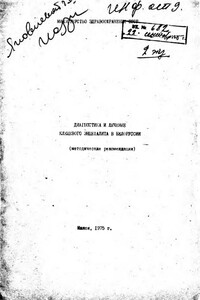Зрелый возраст: Руководство для новичков. 9 шагов к активной и счастливой жизни [заметки]
Сноски
1
Пер. С. Ильина.
2
Пер. Д. Кузнецова.
3
Канеман Д. Думай медленно… Решай быстро. – М.: АСТ, 2013.
4
Дахигг Ч. Сила привычки. Почему мы живем и работаем именно так, а не иначе. – М.: Карьера Пресс, 2012.
5
Пер. А. Федорова.
6
Бубер М. Я и Ты. – М.: Республика, 1995.
Комментарии
1
P. Whitehouse, The Myth of Alzheimer's: What You Aren't Being Told about Today's Most Dreaded Diagnosis (New York: St. Martin's Press, 2008).
2
P. Greenwood and R. Parasuraman, Nurturing the Older Brain and Mind (Cambridge, MA: MIT Press, 2012).
3
R. D. Fields, The Other Brain: From Dementia to Schizophrenia, How New Discoveries about the Brain Are Revolutionizing Medicine and Science (New York: Simon & Schuster, 2009).
4
I. McGilchrist, The Master and His Emissary: The Divided Brain and the Making of the Western World (New Haven: Yale University Press, 2009).
6
Pew Research Center for the People and the Press, poll, Dec. 15, 2010.
7
Y. Taki et al., «Voxel-Based Morphometry of Age-Related Structural Change of Gray Matter for Each Decade in Normal Male Subjects,» paper presented at the Ninth Annual Meeting of the Organization for Human Brain Mapping, New York City, 2003.
8
E. Goldberg, The Wisdom Paradox (New York: Gotham Books, 2006).
9
P. Greenwood and R. Parasuraman, «Ameliorating Cognitive Aging: A Neurocognitive Framework,» chap. 4 in Nurturing the Older Brain and Mind (Cambridge, MA: MIT Press, 2012).
10
Greenwood and Parasuraman, p. 5; Goldberg, p. 11.
11
D. Snowdon et al., «Linguistic Ability in Early Life and Cognitive Function and Alzheimer's Disease in Later Life,» JAMA 275, no. 7 (1996): 528–33.
12
D. J. Simons and C. F. Chabris, «Gorillas in Our Midst: Sustained Inattentional Blindness for Dynamic Events,» Perception 28, no. 9 (May 1999): 1059–74.
13
E. R. Graham and D. M. Burke, «Aging Increases Inattentional Blindness to the Gorilla in Our Midst,» Psychology and Aging 26, no. 1 (Mar. 2011), 162–66.
14
G. Mark et al., «The Cost of Interrupted Work: More Speed and Stress,» Proceedings of the SIGCHI Conference on Human Factors in Computing Systems (2008): 107–10.
15
C. Woolston, «Multitasking and Stress,» HealthDay (Mar. 2013): http://cosumer.healthday.com/encyclopedia/article.asp?AID=646052.
16
Quoted by C. Rosen, «The Myth of Multitasking,» The New Atlantis 20 (Spring 2008): 105–10.
17
E. Ophir et al., «Cognitive Control in Media Multitaskers,» Proceedings of the National Academy of Sciences of the United States of America 106, no. 37 (Sept. 15, 2009): 15583–87.
18
P. Grossman et al., «Mindfulness-Based Stress Reduction and Health Benefits: A Meta-Analysis,» Journal of Psychosomatic Research 57, no. 1 (2004): 35–43.
19
N. E. Morone et al., «Mindfulness Meditation for the Treatment of Chronic Low Back Pain in Older Adults: A Randomized Controlled Pilot Study,» Pain 134 (2008): 310–19.
20
H. Cramer et al., «Mindfulness-Based Stress Reduction for Breast Cancer: A Systematic Review and Meta-Analysis,» Current Oncology 19, no. 5 (2012): 343–52.
21
R. J. Davidson et al., «Alterations in Brain and Immune Function Produced by Mindfulness Meditation,» Psychosomatic Medicine 65 (2003): 564–70.
22
J. D. Creswell et al., «Mindfulness Meditation Training Effects on CD4+ T Lymphocytes in HIV-1 Infected Adults: A Small Randomized Controlled Trial,» Brain, Behavior, and Immunity 23, no. 2 (Feb. 2009): 184–88.
23
M. Killingsworth, «Does Mind-Wandering Make You Unhappy?» Greater Good, July 16, 2013, http://greatergood.berkeley.edu/article/item/does_mind_wandering_make_you_unhappy.
24
W. Hasenkamp et al., «Mind Wandering and Attention during Focused Meditation: A Fine-Grained Temporal Analysis of Fluctuating Cognitive States,» Neuro-Image 59 (2012): 750–60.
25
W. Hasenkamp, «How to Focus a Wandering Mind,» Daily Good, July 17, 2013. http://greatergood.berkeley.edu/article/item/how_to_focus_a_wandering_mind.
26
F. Zeidan et al., «Mindfulness Meditation Improves Cognition: Evidence of Brief Mental Training,» Consciousness and Cognition, 19, no. 2 (June 2010): 597–605.
27
L. Bylsma et al., «A Meta-analysis of Emotional Reactivity in Major Depressive Disorder,» Clinical Psychology Review, 28, no. 4 (Apr. 2008): 676–91.
28
J. Lutz et al., «Mindfulness and Emotion Regulation – an fMRI Study,» Social Cognitive and Affective Neuroscience, doi:10.1093/scan/nst043 (first published online Apr. 5, 2013).
29
E. Luders et al., «The Underlying Anatomical Correlates of Long-Term Meditation: Larger Hippocampal and Frontal Volumes of Gray Matter,» NeuroImage, 45 (2009): 672–78.
30
E. Luders, quoted by M. Wheeler in «How to Build a Bigger Brain,» UCLA News, May 12, 2009, http://newsroom.ucla.edu/portal/ucla/PRN-how-to-build-a-bigger-brain-91273.aspx.
31
J. Johnson, H. Emmons, et al., «Resilience Training for Depressed and Stressed Healthcare Professionals,» Jan. 2014 (submitted for publication).
32
B. Winter et al., «High-Impact Running Improves Learning,» Neurobiology of Learning and Memory 87, no. 4 (2007): 597–609.
33
J. S. Snyder et al., «The Effects of Exercise and Stress on the Survival and Maturation of Adult-Generated Granule Cells,» Hippocampus, Epub ahead of print (Jan. 20, 2009): 1–9, doi:10.1002/hipo.20552.
34
S. Vaynman and F. Gomez-Pinilla, «License to Run: Exercise Impacts Functional Plasticity in the Intact and Injured Central Nervous System by Using Neurotrophins,» Neurorehabilitation and Neural Repair 19, no. 4 (2005): 283–95.
36
Center for Disease Control and Prevention, «One in Five Adults Meets Overall Physical Activity Guidelines,» Press Release, May 2, 2013, http://www.cdc.gov/media/releases/2013/p0502-physical-activity.html.
37
N. Mischel et al., «Physical (In)activity-Dependent Structural Plasticity in Bulbospinal Catecholaminergic Neurons of Rat Rostral Ventrolateral Medulla,» Journal of Comparative Neurology 522, no. 3 (Feb. 15, 2014): 499–513.
38
A. Gow et al., «Neuroprotective Lifestyles and the Aging Brain: Activity, Atrophy, and White Matter Integrity,» Neurology 79, no. 17 (Oct. 2012): 1802–8.
39
K. I. Erickson et al., «Exercise Training Increases Size of Hippocampus and Improves Memory,» Proceedings of the National Academy of Sciences 108, no. 7 (Feb. 15, 2011): 3017–22.
40
J. Mota-Pereira, J. Silverio, et al., «Moderate Exercise Improves Depression Parameters in Treatment-Resistant Patients with Major Depressive Disorder,» Journal of Psychiatric Research 45, no. 8 (Aug. 2011).
41
J. B. Bartholomew et al., «Effects of Acute Exercise on Mood and Well-Being in Patients with Major Depressive Disorder,» Medicine and Science in Sports and Exercise 37, no. 12 (2005): 2032–37.
42
Alzheimer's Association, «2013 Alzheimer's Disease Facts and Figures,» http://www.alz.org/downloads/factsfigures2013.pdf, accessed Jan. 25, 2014.
43
G. Small et al., «Healthy Behavior and Memory Self-Reports in Young, Middle-Aged, and Older Adults,» International Psychogeriatrics 25, no. 6 (June 2013): 981–89.
44
R. Carrington et al., «Cardiorespiratory Fitness and Accelerated Cognitive Decline with Aging,» Journals of Gerontology, doi:10.1093/gerona/glt144 (first published online Nov. 5, 2013).
45
D. Head et al., «Exercise Engagement as a Moderator of the Effects of APOE Genotype on Amyloid Deposition,» Archives of Neurology 69, no. 5 (2012): 636–43.
46
K. Liang et al., «Exercise and Alzheimer's Disease Biomarkers in Cognitively Normal Older Adults,» Annals of Neurology 68, no. 3 (2010): 311–18.
47
E. J. Huang and L. F. Reichart, «Neurotrophins: Roles in Neuronal Development and Function,» Annual Review of Neuroscience 24 (Mar. 2001): 677–736.
48
X. Jiang et al., «BDNF Variation and Mood Disorders: A Novel Functional Promoter Polymorphism and Val66Met Are Associated with Anxiety But Have Opposing Effects,» Neuropsychopharmacology 30 (2005): 1353–61.
49
H. S. Phillips et al., «BDNF mRNA Is Decreased in the Hippocampus of Individuals with Alzheimer's Disease,» Neuron 7, no. 5 (Nov. 1991): 695–702.
50
D. W. Howells et al., «Reduced BDNF mRNA Expression in the Parkinson's Disease Substantia Nigra,» Experimental Neurology 166, no. 1 (Nov. 2000): 127–35.
51
J. L. Warner-Schmidt and R. S. Duman, «Hippocampal Neurogenesis: Opposing Effects of Stress and Antidepressant Treatment,» Hippocampus 16, no. 3 (2006): 239–49.
52
H. van Praag et al., «Running Increases Cell Proliferation and Neurogenesis in the Adult Mouse Dentate Gyrus,» Nature Neuroscience 2 (1999): 266–70.
53
A. A. Garza et al., «Exercise, Antidepressant Treatment, and BDNF mRNA Expression in the Aging Brain,» Pharmacology, Biochemistry and Behavior 77, no. 2 (2004): 209–20.
54
B. Eadie et al., «Voluntary Exercise Increases Neurogenic Activity in the Dentate Gyrus of the Adult Mammalian Brain: Fact of Fiction?» poster presented at the Annual Meeting of the Society for Neuroscience, 2004.
55
L. Byberg et al., «Total Mortality after Changes in Leisure-Time Physical Activity in 50-Year-Old Men: 35-Year Follow-Up of Population-Based Cohort,» British Medical Journal 338 (2009): b668, doi:10.1136/bmj.b688.
56
I. Barnett et al., «Changes in Household, Transport and Recreational Physical Activity and Television Viewing Time across the Transition to Retirement: Longitudinal Evidence from the EPIC-Norfolk Cohort,» Journal of Epidemiology and Community Health", doi:10.1136/jech-2013-203225.
57
B. Liebman, «Chair Today, Gone Tomorrow,» interview with James Levine, MD, Nutrition Action Healthletter 35, no. 3 (Apr. 2008): 3–6.
58
B. Ainsworth, W. Haskell, et al., «2011 Compendium of Physical Activities: A Second Update of Codes and MET Values,» Medicine and Science in Sports and Exercise 43, no. 8: 1575–81 (2011).
59
Heydari et al., «The Effect of High-Intensity Intermittent Exercise on Body Composition of Overweight Young Males,» Journal of Obesity 2012, article ID480467 (2012), http://dx.doi.org/10.1155/2012/480467.
60
J. King, «A Comparison of the Effects of Interval Training vs. Continuous Training on Weight Loss and Body Composition in Obese Pre-Menopausal Women,» M.A. thesis, East Tennessee State University.
61
P. Wahl, «Hormonal and Metabolic Responses to High Intensity Interval Training,» Journal of Sports Medicine and Doping Studies 3, no. 1 (2013): e132, doi:10.4172/2161-0673.1000e132.
62
J. Gillen et al., «Acute High-Intensity Interval Exercise Reduces the Postprandial Glucose Response and Prevalence of Hyperglycaemia in Patients with Type 2 Diabetes,» Diabetes Obesity and Metabolism 14, vol. 6 (June 2012): 575–77.
63
Heydari et al., «The Effect of High-Intensity Intermittent Exercise on Body Composition of Overweight Young Males,» Journal of Obesity (2012), article ID480467, 8 pp. http://dx.doi.org/10.1155/2012/480467.
65
National Institutes of Health, «National Institutes of Health State-of-the-Science Conference Statement on Manifestations and Management of Chronic Insomnia in Adults,» Sleep 28 (June 2005): 1049–57.
66
M. Wang, S. Wang, and P. Tsai, «Cognitive Behavioral Therapy for Primary Insomnia: A Systematic Review,» Journal of Advances in Nursing 50 (2005): 553–64.
69
B. Carey, «Sleep Therapy Seen as an Aid for Depression,» The New York Times, Nov. 18, 2013, accessed Feb. 20, 2014.
70
C. Carney et al., «The Relation between Insomnia Symptoms, Mood, and Rumination about Insomnia Symptoms,» Journal of Clinical Sleep Medicine 9, no. 6 (June 15, 2013): 567–75.
71
J. Suttie, «Why You Should Sleep Your Way to the Top,» Greater Good, Dec. 1, 2013, accessed Feb. 20, 2014. http://greatergood.berkeley.edu/article/item/why_sleep_your_way_top.
72
S. Brand et al., «Adolescents with Greater Mental Toughness Show Higher Sleep Efficiency, More Deep Sleep and Fewer Awakenings after Sleep Onset,» Journal of Adolescent Health 54, no. 1 (Jan. 2014): 109–13.
73
J. Suttie, «Why You Should Sleep Your Way to the Top,» http://greatergood.berkeley.edu/article/item_why_sleep_your_way_top.
74
B. Mander et al., «Prefrontal Atrophy, Disrupted NREM Slow Waves and Impaired Hippocampal-Dependent Memory in Aging,» Nature Neuroscience 16, (2013): 357–64.
75
J. Suttie, «Why You Should Sleep Your Way to the Top.»
76
A. Prather et al., «Gender Differences in the Prospective Associations of Self-Reported Sleep Quality with Biomarkers of Systemic Inflammation and Coagulation: Findings from the Heart and Soul Study,» Journal of Psychiatric Research 47, no. 9 (Sept. 2013): 1228-35, doi:10.1016/j.jpsychires.2013.05.004. Epub 2013 Jun 5.
77
J. Broussard et al., «Impaired Insulin Signaling in Human Adipocytes after Experimental Sleep Restriction,» Annals of Internal Medicine 157 (2012): 549–57.
78
Y. Liu et al., «Association between Perceived Insufficient Sleep, Frequent Mental Distress, Obesity and Chronic Diseases among US Adults, 2009 Behavioral Risk Factor Surveillance System,» BMC Public Health 13 (2013): 84, no. l, doi:10.1186/1471-2458-13-84.
79
A. Jagannath et al., «Sleep and Circadian Rhythm Disruption in Neuropsychiatric Illness,» Current Opinion in Neurobiology 23, no 5 (Oct. 2013): 888–94.
80
F. Benedetti and M. Terman, «Much Ado About… A Moody Clock,» Biological Psychiatry 74, no. 4 (Aug. 15, 2013): 236–37.
81
C. Moller-Levet et al., «Effects of Insufficient Sleep on Circadian Rhythmicity and Expression Amplitude of the Human Blood Transcriptome,» Proceedings of the National Academy of Sciences 110, no. 12 (Mar. 19, 2013): 1132–41.
82
K. Obayashi et al., «Exposure to Light at Night and Risk of Depression in the Elderly,» Journal of Affective Disorders, article in press.
83
R. Lieverse et al., «Bright Light Treatment in Elderly Patients with Nonseasonal Major Depressive Disorder: A Randomized Placebo-Controlled Trial,» Archives of General Psychiatry 68, no. 1 (2011): 61–70, doi:101001/archgenpsychiatry.2010.183.
84
A. Wirzjustice et al., «Chronotherapeutics (Light and Wake Therapy) in Affective Disorders,» Psychological Medicine 35 (2005): 939944, doi:10.1017/S003329170500437X.
85
J. Gooley et al., «Exposure to Room Light before Bedtime Suppresses Melatonin Onset and Shortens Melatonin Duration in Humans,» Journal of Clinical Endocrinology and Metabolism 96, no. 3 (Mar. 2011): E463–472.
86
L. Xie et al., «Sleep Drives Metabolite Clearance from the Adult Brain,» Science 342, no. 6156 (Oct. 18, 2013): 373–77.
87
B. Luscombe, «Your Brain Cells Shrink While You Sleep (And That's a Good Thing),» Time, Oct. 17, 2013, accessed Feb. 23, 2014, http://healthland.time.com/2013/10/17/your-brain-cells-shrink-while-you-sleep-and-thats-a-good-thing/#ixzz2uBRM9BAD.
88
Q. Yang et al., «Added Sugar Intake and Cardiovascular Diseases Mortality among US Adults,» JAMA Internal Medicine 2014, doi:10.1001/jamain_ternmed.2013.13563.
89
R. Chowdhury et al., «Association of Dietary, Circulating, and Supplement Fatty Acids with Coronary Risk: A Systematic Review and Meta-analysis,» Archives of Internal Medicine 160, no. 6 (Mar. 2014): 398–406.
92
K. Duffy and B. Popkin, «Energy Density, Portion Size, and Eating Occasions: Contributions to Increased Energy Intake in the United States, 1977–2006,» PLoS Medicine, 2011, doi:10.1371journal.pmed1001050.
93
G. Vistoli et al., «Advanced Glycoxidation and Lipoxidation End Products (AGEs and ALEs): An Overview of Their Mechanisms of Formation,» Free Radical Research 47, no. 12 (Aug. 2013): Supplement 1: 3–27.
94
S. Shaikh et al., «Advanced Glycation End Products Induce in Vitro Cross-Linking of Alpha-Synuclein and Accelerate the Process of Intracellular Inclusion Body Formation,» Journal of Neuroscience Research 86, no. 9 (July 2008): 2071–82.
95
C. Carvalho et al., «Increased Susceptibility to Amyloid-b Toxicity in Rat Brain Microvascular Endothelial Cells under Hyperglycemic Conditions,» Journal of Alzheimer's Disease 38, no. 1 (Oct. 2013): 75–83.
96
N. Cherbuin et al., «Higher Normal Fasting Plasma Glucose Is Associated with Hippocampal Atrophy: The PATH Study,» Neurology 79, no. 10 (Sept. 4, 2012): 1019–26.
97
P. Crane et al., «Glucose Levels and Risk of Dementia,» New England Journal of Medicine 369 (Aug. 8, 2013): 540–48.
98
R. Wilson et al., «Proneness to Psychological Distress Is Associated with Risk of Alzheimer's Disease,» Neurology 61 (2003):1479–85.
99
L. Tsai and R. Madabhushi, «Alzheimer's disease: A Protective Factor for the Ageing Brain,» Nature 507 (Mar. 27, 2014): 439–40, doi:10.1038/nature13214.
100
M. Parrott and C. Greenwood, «Dietary Influences on Cognitive Function with Aging: From High-Fat Diets to Healthful Eating,» Annals of the New York Academy of Sciences 1114 (2007): 389–97.
101
A. Rubio-Tapia et al., «Increased Prevalence and Mortality in Undiagnosed Celiac Disease,» Gastroenterology 137, no. 1 (July 2009): 88–93, doi:10.1053/j.gastro.2009.03.059.
102
A. Vajdani, «The Characterization of the Repertoire of Wheat Antigens and Peptides Involved in the Humoral Immune Responses in Patients with Gluten Sensitivity and Crohn's Disease,» ISRN Allergy (Oct. 27, 2011), doi:10.5402/2011/950104.
103
S. Collins et al., «The Adoptive Transfer of Behavioral Phenotype via the Intestinal Microbiota: Experimental Evidence and Clinical Implications,» Current Opinion in Microbiology 16, no. 3 (June 2013): 240–45.
104
G. Clarke et al., «The Microbiome-Gut-Brain Axis during Early Life Regulates the Hippocampal Serotonergic System in a Sex-Dependent Manner,» Molecular Psychiatry 18, no. 6 (June 12, 2012): 666–73, doi:10.1038/mp.2012.77.
105
T. Dinan et al., «Psychobiotics: A Novel Class of Psychotropic,» Biological Psychiatry 74, no. 10 (Nov. 15, 2013): 720–26.
106
J. Bravo et al., "Ingestion of Lactobacillus Strain Regulates Emotional Behavior and Central GABA Receptor Expression in a Mouse via The Vagus Nerve," Proceedings of the National Academy of Sciences 108, no. 38 (2011): 16050–55, doi:10.1073/pnas.102999108.
107
J. Markle et al., «Sex Differences in the Gut Microbiome Drive Hormone-Dependent Regulation of Autoimmunity,» Science 339, no. 6123 (Jan. 17, 2013): 1084–88, doi:10.1126/science.1233521.
108
Helmholtz Centre For Environmental Research – UFZ, «GI Tract Bacteria May Protect against Autoimmune Disease,» ScienceDaily, Jan. 17, 2013.
109
M. Houston, «The Role of Nutrition and Nutraceutical Supplements in the Treatment of Hypertension,» World Journal of Cardiology 6, no. 2 (Feb. 26, 2014): 38–66.
110
T. Pentinat et al., «Transgenerational Inheritance of Glucose Intolerance in a Mouse Model of Neonatal Overnutrition,» Endocrinology 151, no. 12 (Dec. 2010): 5617–23, doi:10.1210/en.2010-0684.
111
G. Kaati et al. «Cardiovascular and Diabetes Mortality Determined by Nutrition during Parents' and Grandparents' Slow Growth Period,» European Journal of Human Genetics 10 (2002): 682–88.
112
H. Tapp et al., «Nutritional Factors and Gender Influence Age-Related DNA Methylation In the Human Rectal Mucosa,» Aging Cell (2012), doi:10.1111/acel.12030.
113
J. V. Sanchez-Mut et al., «Promoter Hypermethylation of the Phosphatase DUSP22 Mediates PKA-Dependent TAU Phosphorylation and CREB Activation in Alzheimer's Disease,» Hippocampus (2014), doi:10.1002/hipo.22245.
114
P. Elwood et al., «Healthy Lifestyles Reduce the Incidence of Chronic Diseases and Dementia: Evidence from the Caerphilly Cohort Study,» PLoS One (Dec. 2013), doi:10.1371/journal.pone.0081877.
115
D. Ornish et al., «Effect of Comprehensive Lifestyle Changes on Telomerase Activity and Telomere Length in Men with Biopsy-Proven Low-Risk Prostate Cancer: 5-Year Follow-Up of a Descriptive Pilot Study,» Lancet Oncology 14, no. 11 (Oct. 2013): 1112–20.
116
A. Tiainen et al., «Leukocyte Telomere Length and Its Relation to Food and Nutrient Intake in an Elderly Population,» European Journal of Clinical Nutrition, 66, no. 12 (Dec. 2012): 1290–94.
118
E. Guallar et al., «Enough Is Enough: Stop Wasting Money on Vitamin and Mineral Supplements,» Annals of Internal Medicine 159, no. 12 (Dec. 17, 2013): 850–51.
119
F. Grodstein et al., «A Randomized Trial of Long-term Multivitamin Supplementation and Cognitive Function in Men: The Physicians' Health Study II,» Annals of Internal Medicine 159, no. 12 (Dec. 17, 2013): 806–14.
120
J. Walker et al., "Oral Folic Acid and Vitamin B-12 Supplementation to Prevent Cognitive Decline in Community-Dwelling Older Adults with Depressive Symptoms – The Beyond Ageing Project: A Randomized Controlled Trial, American Journal of Clinical Nutrition 95, no. 1 (Jan. 2012): 194–203.
121
A. D. Smith et al., «Homocysteine-Lowering by B Vitamins Slows the Rate of Accelerated Brain Atrophy in Mild Cognitive Impairment: A Randomized Controlled Trial,» PLoS One 5, no. 9 (Sept. 2010), doi:10.1371/journal.pone.0012244.
122
B. Small et al., «Nutraceutical Intervention Improves Older Adults' Cognitive Functioning,» Rejuvenation Research, 17, no. 1 (Feb. 2014): 27–32.
123
G. Douaud et al., «Preventing Alzheimer's Disease-Related Gray Matter Atrophy by B-Vitamin Treatment,» Proceedings of the National Academy of Sciences 110, no. 23 (June 2013): 9523–28.
125
J. Dysken et al., «Effect of Vitamin E and Memantine on Functional Decline in Alzheimer Disease,» JAMA 311, no. 1 (Jan. 2014): 33–44.
126
J. Sanmukhani et al., «Efficacy and Safety of Curcumin in Major Depressive Disorder: A Randomized Controlled Trial,» Phytotherapy Research 28, no. 4 (Apr. 2014): 579–85.
127
T. Crook et al., «Effects of Phosphatidylserine in Alzheimer's disease,» Pharmacology Bulletin 28, no. 1 (1992): 61–66.
129
J. Douillard, The 3-Season Diet (New York: Harmony Books, 2001).
130
M. Levine et al., «Low Protein Intake Is Associated with a Major Reduction in IGF-1, Cancer, and Overall Mortality in the 65 and Younger but Not Older Population,» Cell Metabolism 19, no. 3 (2014): 407–17, doi:10.1016/j.cmet.2014.02.006.
133
S. Weyerer et al., «Current Alcohol Consumption and Its Relationship to Incident Dementia: Results from a 3-Year Follow-Up Study among Primary Care Attenders Aged 75 Years and Older,» Age Ageing 40 (2011): 456–63.
134
S. Sabia et al. «Alcohol Consumption and Cognitive Decline in Early Old Age,» Neurology 82 (2014): 332–39.
135
J. Rodrigue et al., «Induced Mood and Curiosity,» Cognitive Therapy and Research 11, no. 1 (1987): 101–6.
136
J. Litman and T. Jimerson, «The Measurement of Curiosity as a Feeling of Deprivation,» Journal of Personality 82, no. 2 (2004): 147–57.
137
J. E. Joseph, X. Liu, Y. Jiang, D. Lynam, and T. H. Kelly, «Neural Correlates of Emotional Reactivity in Sensation Seeking,» Psychological Science 20, no. 2 (2008): 215–23.
138
M. Kang et al., «The Hunger for Knowledge: Neural Correlates of Curiosity» (manuscript), Division of Humanities and Social Sciences, California Institute of Technology.
139
T. B. Kashdan and M. F. Steger, «Curiosity and Pathways to Well-Being and Meaning in Life: Traits, States, and Everyday Behaviors,» Motivation and Emotion 31, no. 3 (2007), 159–73.
140
T. B. Kashdan and P. J. Silvia (2009), «Curiosity and Interest: The Benefits of Thriving on Novelty and Challenge,» in S. J. Lopez, ed., Handbook of Positive Psychology, 2nd ed. (New York: Oxford University Press).
141
D. C. Park and I. McDonough, «The Dynamic Aging Mind: Revelations from Functional Neuroimaging Research,» Perspectives in Psychological Science 8 (2013): 62–67.
142
L. Shlain, Art & Physics: Parallel Visions in Space, Time and Light (New York: Harper Perennial, 1991).
143
Shlain, ibid., p. 16.
144
L. Carroll, Alice's Adventures In Wonderland, chap. 1, «Down the Rabbit Hole» (New York: Bantam Dell, 1981; first published 1865).
145
W. Pisula et al., «Comparative Psychology as Unified Psychology: The Case of Curiosity and Other Novelty-Related Behavior,» Review of General Psychology 17, no. 2 (2013): 224–29.
146
J. Litman, «Curiosity and the Pleasures of Learning: Wanting and Liking New Information,» Cognition and Emotion 19, no. 6 (2005): 793–814.
147
A. Gosline, «Bored to death: Chronically Bored People Exhibit Higher Risk-Taking Behavior,» Scientific American, Feb. 26, 2007, www.sciam.com/article.cfm?id=bored – find-something-to-live-for.
148
C. Yarnal and X. Qian, «Older-Adult Playfulness: An Innovative Construct and Measurement for Healthy Aging Research,» American Journal of Play 4, no. 1 (2011): 52–79.
149
Robert Frost, «The Road Not Taken» (poem), Mountain Interval (New York: Henry Holt, 1915).
150
E. Goldberg, The Wisdom Paradox (New York: Gotham Books, 2005).
151
C. Herzog et al., «Enrichment Effects on Adult Cognitive Development,» Psychological Science in the Public Interest 9, no. 1 (2008): 1–65.
152
B. Chanowitz and E. Langer, «Premature Cognitive Commitment,» Journal of Personality and Social Psychology 41, no. 6 (1981): 51–63.
153
E. Langer, Mindfulness (New York: Da Capo Press, 1989).
154
C. Coppens et al. (2010). «Coping Styles and Behavioural Flexibility: Towards Underlying Mechanisms,» Philosophical Transactions of the Royal Society 365, no. 1560 (2015): 4021–28.
155
C. Coppens et al. (2010). «Coping Styles and Behavioural Flexibility: Towards Underlying Mechanisms,» Philosophical Transactions of the Royal Society 365, no. 1560 (2015): 4021–28.
156
D. Kahneman, Thinking, Fast and Slow (New York: Farrar, Straus and Giroux, 2011).
157
J. Hawley, The Bhagavad Gita: A Walkthrough for Westerners (San Francisco: New World Library, 2001).
158
M. Merzenich, Soft-Wired, 2nd ed. (San Francisco: Parnassus Publishing, 2013).
159
D. Durstewitz et al. «Abrupt Transitions between Prefrontal Neural Ensemble States Accompany Behavioral Transitions during Rule Learning,» Neuron 66 (2010): 438–48.
160
S. Floresco, «Prefrontal Dopamine and Behavioral Flexibility,» Frontiers in Neuroscience 7, no. 62 (2013).
161
G. Buzsáki, Rhythms of the Brain (New York: Oxford University Press, 2006).
162
K. Druck, The Real Rules of Life: Balancing Life's Terms with Your Own (New York: Hay House Publishing, 2012), p. vxi.
163
D. Zabelina and M. Beeman, «Short-Term Attentional Perseveration Associated with Real-Life Creative Achievement,» Frontiers in Psychology 4 (2013): 191.
164
Там же.
165
A. S. Griffin, D. Guez, F. Lermite, and M. Patience, «Tracking Changing Environments: Innovators Are Fast, but Not Flexible Learners,» PLoS ONE8, no. 12 (2013): e84907, doi10.1371/journal.pone.0084907.
166
P. Greenwood, Nurturing the Older Brain and Mind (Cambridge, MA: MIT Press, 2012).
167
J. Singer, Memories that Matter (Oakland, CA: New Harbinger Publications, 2005).
168
D. Hecht, "The Neural Basis of Optimism and Pessimism," Experimental Neurobiology 22, no. 3 (2013): 173–99.
169
A. Reading, Hope and Despair: How Perceptions of the Future Shape Human Behavior (Baltimore: The Johns Hopkins University Press, 2004), 3.
170
L. Abramson, M. Seligman, and J. Teasdale, «Learned Helplessness in Humans: Critique and Reformulation,» Journal of Abnormal Psychology 87, no. 1 (1978): 49–74.
171
T. Sharot et al., «Dopamine Enhances Expectation of Pleasure in Humans,» Current Biology (2009), doi:10.1016/j.cub.2009.10.025.
172
T. Sharot, C. Korn, and R. J. Dolan, «How Unrealistic Optimism Is Maintained in the Face of Reality,» Nature Neuroscience 14 (2011): 1475–79.
173
C. Moutsiana, N. Garrett, R. C. Clarke, R. B. Lotto, S. J. Blakemore, and T. Sharot, "Human Development of the Ability to Learn from Bad News, Proceedings of the National Academy of Sciences 110, no. 41 (2013): 16396–401.
174
R. Hanson and R. Mendius, Buddha's Brain: Practical Neuroscience of Happiness, Love and Wisdom (Oakland, CA: New Harbinger Publications, 2009).
175
C. Korn, T. Sharot, H. Walter, H. R. Heekeren, and R. J. Dolan, «Depression Is Related to an Absence of Optimistically Biased Belief Updating about Future Life Events,» Psychological Medicine 44 (2014): 579–92.
176
R. Chowdhury, T. Sharot, T. Wolfe, E. Düzel, and R. J. Dolan, «Optimistic Update Bias Increases in Older Age,» Psychological Medicine 4 (2013): 1–10.
177
M. Gallagher, S. Lopez, and S. Pressman, «Optimism Is Universal: Exploring the Presence and Benefits of Optimism in a Representative Sample of the World,» Journal of Personality 81, no. 5 (2013): 429–40.
178
R. Chowdhury, T. Sharot, T. Wolfe, E. Düzel, and R. J. Dolan, «Optimistic Update Bias Increases in Older Age.»
179
S. H. Kim, B. Cornwell, and S. E. Kim, «Individual Differences in Emotion Regulation and Hemispheric Metabolic Asymmetry,» Biological Psychology 89 (2012): 382–86.
180
R. Davidson, «Affective Neuroscience and Psychophysiology: Toward a Synthesis,» Psychophysiology 40, no. 5 (2003): 655–65.
181
K. Kakolewski et al., «Laterality Word Valence, and Visual Attention: A Comparison of Depressed and Non-Depressed Individuals,» International Journal of Psychophysiology 34 (1999): 283–92.
182
M. Seligman, Learned Optimism: How to Change Your Mind and Your Life, 2nd ed. (New York: Pocket Books, 1998).
183
M. Yapko, Depression Is Contagious (New York: Free Press, 2009).
184
A. Leaver, J. Van Lare, B. Zielinski, A. Halpern, and J. Rauschecker, «Brain Activation during Anticipation of Sound Sequences,» Journal of Neuroscience 29, no. 8 (2009), 2477, doi:10.1523/JNEUROSCI.4921-08.2009.
185
K. Walker and A. King, «Auditory Neuroscience: Temporal Anticipation Enhances Cortical Processing,» Current Biology 12:21, no. 7 (2011), R251–3, doi:10.1016/j.cub.2011.02.022.
186
R. Sapolsky, «Are Humans Just Another Primate?» Pritzker Lecture, California Academy of Sciences, Feb. 15, 2011: retrieved Apr. 20, 2014, from http://video.calacademy.org/details/349.
187
J. Crabtree, "Agnes the Ageing Suit," FT Magazine, July 22, 2011: retrieved May 6, 2014, from www.ft.com/cms/s/2/1fed1eee-b34b-11e0-9af2-00144feabdc0.html.
188
P. Bailey and J. Henry, «Growing Less Empathic with Age: Disinhibition of the Self-Perspective,» Journal of Gerontology 63B, no. 4 (2008): 19–26.
189
G. Labouvie-Vief et al., «Dynamic Emotion-Cognition Interactions in Development: Arousal, Stress, and the Processing of Affect,» in Aging and Cognition, ed. H. B. Bosworth and C. Hertzog (Washington, DC: American Psychological Association, 2009).
190
W. Cannon, «The James-Lange Theory of Emotions: A Critical Examination and an Alternative Theory,» The American Journal of Psychology 39 (1927): 106–24.
191
G. Rizzolatti et al., «Functional Organization of Inferior Area 6 in the Macaque Monkey: Area 5 and the Control of Distal Movements,» Experimental Brain Research 71 (1998): 491–507.
192
V. Gallese and A. Goldman, «Mirror Neurons and the Stimulation Theory of Mind-Reading,» Trends in Cognitive Sciences 2 (1998): 493–501.
193
T. Insel and L. Young, «The Neurobiology of Attachment,» Nature Reviews: Neuroscience 2 (2001): 129–36.
194
A. Schore, «Effects of a Secure Attachment Relationship on Right Brain Development, Affect Regulation and Infant Mental Health,» Infant Mental Health Journal 1–2 (2001): 7–66.
195
A. Schore, «Attachment and Regulation of the Right Brain,» Attachment and Human Development 2, no. 1 (2000): 23–47.
196
A. Schore, «Paradigm Shift: The Right Brain and the Relational Unconscious,» American Psychological Association, invited speaker, lecture conducted for Plenary Session at the American Psychological Association Annual Convention, Toronto, Canada, Aug. 8, 2009.
197
A. Schore, «Effects of a Secure Attachment Relationship.»
198
A. Schore, «Attachment and Regulation of the Right Brain.»
199
A. Schore, «Paradigm Shift.»
200
W. A. Collins and L. A. Sroufe, «Capacity for Intimate Relationships: A Developmental Construction,» in W. Furman, B. B. Brown, and C. Feiring, eds., The Development of Romantic Relationships in Adolescence (New York: Cambridge University Press, 1999).
201
M. Solomon, «Emotion in Romantic Partners: Intimacy Found, Intimacy Lost, Intimacy Reclaimed,» in D. Fosha, D. Siegel, and M. Solomon, eds., The Healing Power of Emotion: Affective Neuroscience, Development and Clinical Practice (New York: W. W. Norton, 2009).
202
M. Lucas, Rewire Your Brain for Love: Creating Vibrant Relationships Using the Science of Mindfulness (Carlsbad, CA: Hay House Publishing, 2012).
203
J. Sze et al., «Greater Emotional Empathy and Prosocial Behavior in Late Life,» Emotion 12, no. 5 (2012): 1129–40.
204
R. Levenson, «Emotion and Emotion Regulation,» in Changing Emotions, ed. D. Hermans, B. Rime, and B. Mesquita (New York: Psychology Press, 2013), 105–12.
205
G. Labouvie-Vief, Psyche and Eros: Mind and Gender in The Life Course (New York: Cambridge University Press, 1995).
206
B. Kok et al., «How Positive Emotions Build Physical Health: Perceived Positive Social Connections Account for Upward Spiral between Positive Emotions and Vagal Tone,» Psychological Science 24, no. 7 (2013): 1123–32.
207
C. D. Batson et al., eds., «Empathy and Altruism,» Oxford Handbook of Positive Psychology, 2nd ed. (New York: Oxford University Press, 2009).
208
B. Schwartz, Rippling: How Social Entrepreneurs Spread Innovation throughout the World (New York: John Wiley & Sons, 2012).
209
T. Hacker, «Building Empathy Builds Society,» The Seattle Times, Jan. 28, 2013.
210
J. Eakin, Living Autobiographically: How We Create Identity in Narrative (Ithaca: Cornell University Press, 2008).
211
P. Eriksson and L. Wallin, «Functional Consequences of Stress-Related Suppression of Adult Hippocampal Neurogenesis: A Novel Hypothesis on the Neurobiology of Burnout,» Acta Neurologica Scandinavia 110, no. 5 (2004): 275–80.
212
J. D. Bremner, Does Stress Damage the Brain? (New York: W. W. Norton & Co., 2002).
213
M. Crockett et al., «Serotonin Selectively Influences Moral Judgment and Behavior through Effects on Harm Aversion,» Proceedings of The National Academy of Sciences 107, no. 40 (2010), retrieved May 19, 2014, doi:10.1073/pnas.1009396107.
214
J. T. Cacioppo et al., «Social Neuroscience: Progress and Implications for Mental Health,» Perspectives on Psychological Science 2, no. 2 (2007): 99–123.
215
C. Yarnal and X. Qian, «Older-Adult playfulness: An Innovative Construct and Measurement for Healthy Aging Research,» American Journal of Play 4, no. 1 (2011): 52–78.
216
E. Y. Cornwell and L. J. Waite, «Social Disconnectedness, Perceived Isolation, and Health among Older Adults,» Journal of Health and Social Behavior 50, no. 1 (2009): 31–48.
217
T. Schmid, Promoting Health through Creativity: For Professionals in Health, Arts and Education (London, England: Whurr Publishers Ltd., 2005).
218
C. Pasquaretta et al., «Social Networks in Primates: Smart and Tolerant Species Have More Efficient Networks,» Scientific Reports 4, Article number 7600 (Dec. 2014), doi:10.1038/srep07600.
219
K. M. Kendrick, «The Neurobiology of Social Bonds,» Journal of Neuroendocrinology 16, no. 12 (Dec 2004): 1007–8.
220
P. L. Wachtel, Relational Therapy and the Practice of Psychotherapy (New York: Guilford Publishing, 2008).
221
L. Cozolino, The Neuroscience of Human Relationships: Attachment and the Developing Social Brain (New York: W. W. Norton, 2006).
222
D. Wallin, Attachment in Psychotherapy (New York: Guilford Publishing, 2007), 101.
223
L. M. Matire and M. M. Franks, «The Role of Social Networks in Adult Health: Introduction to the Special Issue,» Health Psychology 33, no. 6 (2014), 501–4.
224
J. K. Kiecolt-Glaser and T. L. Newton, «Marriage and Health: His and Hers,» Psychological Bulletin 127 (2001): 472–503.
225
M. M. Franks et al., «I Will If You Will: Similarity in Health Behavior Change of Married Partners,» Health Education and Behavior 39 (2012): 324–31.
226
R. S. Sneed, and S. Cohen, «Negative Social Interactions and Incident Hypertension among Older Adults,» Health Psychology 33 (2014): 554–65.
227
S. T. Cheng et al., «Physical and Social Activities Mediate the Associations between Social Network Types and Ventilator Function in Chinese Older Adults,» Health Psychology 33 (2014): 524–34.
228
J. Hollis, The Eden Project: In Search of the Magical Other (Toronto: Inner City Books, 1998), 13.
229
C. J. Jung, «Commentary on 'The Secret of the Golden Flower,'» in Collected Works, vol.13, Alchemical Studies (UK: Routledge & Kegan Paul, 1967), 47–48.
230
U. S. Department of Health and Human Services, "Prevention Makes Common 'Cents' ": http://aspe.hhs.gov/health/prevention/prevention.pdf (2003).
231
A. Golay et al., «Motivating for Change: A New Approach,» Service of Therapeutic Education for Chronic Diseases, Didactic Science Laboratory, Geneva, Switzerland, 2012.
232
N. L. Kerr and C. M. Kaufman-Gililand, «Communication, Commitment, and Cooperation in Social Dilemma,» Journal of Personality and Social Psychology 66, no. 3 (1994): 513–29.
233
K. M. Brethel-Haurwitz and A. A. Marsh, Geographical Differences in Subjective Well-Being Predict Extraordinary Altruism, Psychological Science 25, no. 3 (2014): 762–71.
234
V. E. Frankl, The Unheard Cry for Meaning: Psychotherapy and Humanism (New York: Simon & Schuster, 1978).
235
M. Freedman, Encore: Finding Work That Matters in the Second Half of Life (New York: Perseus Books Group, 2007).
236
W. Muller, How, Then, Shall We Live? (New York: Bantam, 1996).
237
M. Buber, I and Thou (New York: Charles Scribner's Sons, 1970).
238
E. Renehan et al., «Healthy Aging Literature Review,» National Ageing Research Institute and Council on the Ageing, 2012, prepared for the Victoria, Australia, Department of Health, www.health.vic.gov.au/agedcare.
239
B. Cornwell, E. O. Laumann, and L. P. Schumm, «The Social Connectedness of Older Adults: A National Profile,» American Sociological Review 73, no. 2 (2008): 185–203.
240
Quoted from «Addressing Isolation among Older Adults: The Role of Social Connectedness in Healthy Aging,» report of The National Council on Aging, 2014, www.illuminage.com/webinars/presentations/webinar-052214.pdf.
241
C. A. Emlet and J. T. Moceri, «The Importance of Social Connectedness in Building Age-Friendly Communities,» Journal of Aging Research 2012, article ID173247, 9 pages, http://dx.doi.org/10.1155/2012/173247.
242
V. Toepoel, «Aging, Leisure, and Social Connectedness: How Could Leisure Help Reduce Social Isolation of Older People?» Social Indicators Research 113 (2013): 355–72.
243
D. Whyte, Everything Is Waiting for You (Langley, WA: Many Rivers Press, 2003).
244
http://rabbidavidkominsky.com/tag/zusya/. Used with permission.
245
P. Palmer, Let Your Life Speak: Listening to the Voice of Vocation (New York: John Wiley & Sons, 2000).
246
Там же.
247
P. Nelson, There's A Hole in My Sidewalk (Hillsboro, OR: Beyond Words, 1993).
248
M. Oliver, «When Death Comes,» New and Selected Poems (Boston: Beacon Press, 2004).
249
S. Haldeman-Martz, ed., If I Had My Life to Live Over, I Would Pick More Daisies (Watsonville, CA: Papier-Mache Press, 2010).
250
W. Muller, A Life of Being, Having, and Doing Enough (New York: Harmony, 2011).

Наш мозг в зрелом возрасте не только не увядает, но и сохраняет способность учиться и развиваться — это доказанный современной наукой факт. Интересная, активная и здоровая старость, о которой мечтает каждый, сегодня вполне достижима. Практикующий психотерапевт Генри Эммонс и нейропсихолог Дэвид Олтер рассказывают об уникальных методах оздоровления мозга, упражнениях на остроту ума и о правилах, следуя которым вы будете встречать каждый новый день с радостью. Из книги вы узнаете: как физическая нагрузка влияет на здоровье мозга, эмоции и энергичность; как решать проблемы со сном; как правильное питание действуют на работу мозга; как настроить себя на позитивный лад и о многих других способах, которые позволят в преклонном возрасте быть активными и счастливыми.

В тайниках тела (Приключения в микромире. Том VI). — Б.м.: Salamandra P.V.V., 2014. - 155 c., илл. — (Polaris: Путешествия, приключения, фантастика. Вып. LХI). Гигантские пауки и крошечные люди, кровопролитные битвы муравьев, отчаянные сражения микробов, путешествия внутри человеческого тела и невообразимые вселенные, заключенные в атомах — проникновение в микромир издавна было заветной мечтой фантастов. Публикацию забытых и редких произведений, объединенных общей темой «приключений в микромире», продолжает в серии «Polaris» познавательная книга Г.

В книге рассказывается история главного героя, который сталкивается с различными проблемами и препятствиями на протяжении всего своего путешествия. По пути он встречает множество второстепенных персонажей, которые играют важные роли в истории. Благодаря опыту главного героя книга исследует такие темы, как любовь, потеря, надежда и стойкость. По мере того, как главный герой преодолевает свои трудности, он усваивает ценные уроки жизни и растет как личность.

В этой книге говорится об Исконной Вере и Стари у Южных Славян. Исследование, которое мы провели, не основывается на песнях, преданиях и обрядах, сохранившихся до сих пор, ни даже на письменных летописях. Главная особенность научного подхода, примененного в этой книге, это его опора на образные представления, которые у Южных Славян, совместно со многими другими народами, возникли со временем.

«Древние люди летали в космос!», «Гагарин не был первым космонавтом!», «Американцы сфальсифицировали высадку на Луну!», «Космонавты встречали инопланетян и ангелов!». Подобные заголовки часто встречаются в прессе. В них не было бы большой беды, если бы из-за порождаемых мифов не формировалось конспирологическое мировоззрение, отрицающее историю космонавтики и достижения науки. Космическую мифологию легко опровергнуть фактами, но чтобы добраться до них, нужны знания и опыт. Книга Антона Первушина, писателя и научного журналиста, поможет сориентироваться в потоках информации и научиться отделять правду от вымысла.

В книге рассказывается история главного героя, который сталкивается с различными проблемами и препятствиями на протяжении всего своего путешествия. По пути он встречает множество второстепенных персонажей, которые играют важные роли в истории. Благодаря опыту главного героя книга исследует такие темы, как любовь, потеря, надежда и стойкость. По мере того, как главный герой преодолевает свои трудности, он усваивает ценные уроки жизни и растет как личность.

Всю жизнь мы видим сны: впервые они являются нам в утробе матери и не покидают до смертного часа. Но что же такое — сон? Нужен ли человеку этот «бесценный дар Морфея»? Можно ли считать сном гипноз? Почему во сне вспоминается забытое, казалось бы, навсегда? Есть ли связь между сном и памятью? Ответы на эти вопросы вы найдете в работе, посвященной этим еще не до конца изученным проблемам, связанным с деятельностью мозга.* * * Подписная серия «Знак вопроса» издательства «Знание» выпускалась ежемесячно, начиная с 1989 года.